I love how looking up at the facade from the dock on the Grand Canal one is faced with dozens of carved peering faces looking down.
Though started in 1649 the baroque palazzo wasn't finished until 1756 and has been a house museum devoted to 18th century living in Venice since 1936. Before becoming a museum however its inhabitants were a literal who's who: Cole Porter, John Singer Sargent, and Robert Browning to name a few.
The lower level which has seen its fair share of weathering floods is composed of marble flooring and stucco on stone walls.
The ground floor is primarily open space (open to the weather) and circulation. The Cafe, bookshop, and offices now fill the ground floor and mezzanine spaces of the palazzo.
An antique gondola stands guard at the side entrance to a smaller canal. A law passed in the 16th century decreed that all gondolas be painted black to avoid them from becoming overly opulent.
A large grand staircase at the back of the building near the rear garden leads one from the ground level to the ballroom on the Piano Nobile.
Loved this elegant wood cart for one.
The large 2 story ballroom features trompe l'oeil wall paintings by Pietro Visconti and the ceiling painted by Giovanni Battista Crosato depicts Apollo in his carriage. The enormous gilded wood chandelier were electrified early in the 20th century.
Rather than hallways all of the rooms connect via a long enfilade with a large central gallery or portego connecting the rooms.
Above is a diagrammatic floorplan showing the layout from wikipedia.
As with everywhere in Venice each view is postcard perfect. Above is a smaller canal along the side of the palazzo seen from the ballroom.The wall treatments deal with an asymmetrical door to the main stair in an interesting way I felt.
The chapel has a wedding bay protruding out over the canal added in 1758 for the marriage of Ludovico Rezzonico.
The rococo plasterwork is astounding.
The ceiling is not forgotten!
The display cases in the chapel display a large collection of 18th century coffeecups; this one in particular was interesting in that it looks so modern!
Naturally Murano glass chandeliers decorate each room. I never really understood or liked these glass confections until visiting Venice: when you see them in place you just get it. I'm a fan now.
The throne room features an ornate throne for a priest by rococo artist Antonio Corradini.
The astounding frame and ceilings decorated by Tiepolo come from the patrician Barbarigo family.
The view from the throne room is of the Grand Canal -not too shabby.
I loved the sketchy wall frescoes.
The large portego would be used for waiting guests and parties.
Another painting by Tiepolo decorates the ceiling of the room flanking the throne room on the Grand Canal (known as the Tiopolo room) as well as the extraordinary secretary desk below and some beautiful Fortuny wall coverings.
The fireplaces were peculiar to me as I had never seen them so shallow. They naturally would throw more heat off into the room but how do they draw smoke?
As the floors are all terrazzo (polished marble chips in cement) hearths are not necessary.
All of the mirror becomes 'antiqued' rather quickly in the humid Venetian air which is so lovely and artful.
The museum is sparsely furnished to give precedence to the architecture and wall paintings but all of the objects are amazing.
A view into the center hall portego.
A great way to enhance sconces with mirror.
The Lazzarini room features ceiling medallions painted by a Venetian painter, Francesco Maffei, in the 1650s.
This chandelier is the most exquisite in the museum and sums up all of the light-hearted fun and gaiety these are meant to inspire ; party time! A matching standing lamp is in a case upstairs.
This 18th century wall bust of Medusa is a tad more somber in the portego.The stair leading up to higher floors features the Venetian Lion as railing end caps.
The most well known items from the collection are the fabulous Tiepolo frescos from the Villa at Zianigo dating to the late 18th century.
They were sold and removed from the villa in 1906 but the ministry of education blocked their exportation to France and they were purchased by the Venetian Town Council.
They were installed at the museum in 1936 to their original layout as much as possible and recently restored in 1999.
I think the architectural wall treatment of the frescoes is the most interesting: instant architecture to plain walls with faux paneling.
This ceiling fresco of Pulcinella may be the most famous.
Being Venice many of the rooms are covered in glorious Fortuny fabric. Matching fabric upholsters the furniture.
The museum is large and these photos cover only a handful of the astounding collection.
One can't have a museum devoted to the 18th century without a chinoiserie room. This furniture dates from the 1750s.
My favorite rooms in the palazzo are on the back of the 2nd floor - an 18th century paneled alcove bedroom imported from the Palazzo Carminati.
Another enfilade view back towards the Grand Canal.
Behind the alcove is another paneled room which was an exquisite jewel box.
Antique mirror reflects light and the playful wall treatment retains its original painted finish.
This small boudoir was too small to photograph well but I couldn't take enough pictures of the details!
This is how I like my mirror - heavily antiqued!!
The best picture I could get of the paneled boudoir.
The original architectural toile found in the bed alcove is something I wish would be reprinted today!
The front entry is onto the Grand Canal -how is that for a view?
A large garden is located behind the fountain above. I hope you enjoyed this tour through the Ca'Rezzonico with me. If you are ever in Venice this wonderful museum should top your list of things to see!



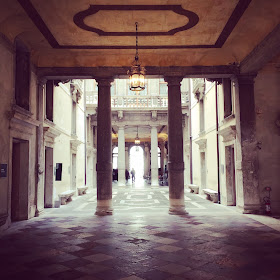

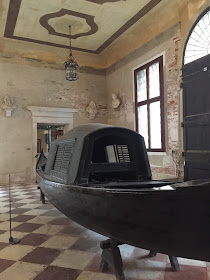

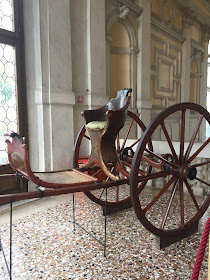










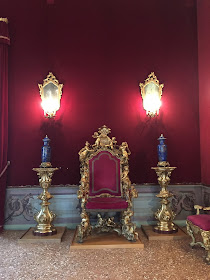


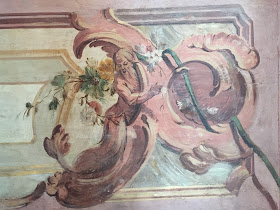





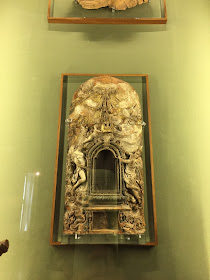

























I enjoyed your trip via IG but the pictures of Venice are magnificent. I have always been a Murano fan and if it weren't for the crowds I would love to go to Venice for a trip that is overdue.
ReplyDeleteThe details are exquisite! Thanks.
ReplyDeleteStefan,
ReplyDeleteGreat post! Ah Venice...La Serenissima...it is too divine! Am re-reading my copy of Brideshead Revisited, by Evelyn Waugh, (1944)and Sebastian and Charles go off to visit Papa (Lord Marchmain) who is Sebastian's father- and he is residing in a Castello in Venice- there is mention of a bathroom with no ceiling! (Open to the sky) and then, boom! a jet of water goes soaring up ! So, the boys are brought a basin of hot water with which to bathe- imagine the plumbing! Yikes! Have only been once myself, dying to return, would love to go back and would also love to be part of the "Save Venice" foundation- Did you have time to visit any of the islands such as Burano or Murano? Loved this post and your pictures and comments were great too. Jan Morris, one of the first transsexuals wrote a famous book about Venice. I met his son when I lived in Bath, Avon, as part of my early education. So interesting!
Thank you! It's so hard to imagine it was once a home? And with those views. I love all the details you pointed out - you make a great tour guide, thank you!!!!!!!!!!! The fortuny!!!!! the mirrors!! The chandeliers!!! Just amazing.
ReplyDeleteSounds like a fabulous trip and viewing all of your splendid photos has me hankering for a trip to Venice (haven't visited since my parents took us there are teenagers).
ReplyDeleteYou are so right about that cup and saucer - looks so modern.
I look forward to more posts from your travels.
What a fabulous post. My daughter and I visited Venice this past summer and were battling the overcrowded city. In planning where to go that week, I thought the Ca' Rezzonico sounded intriguing. Luckily, my daughter indulged her mother and we had a great day. Besides the obvious jewel this place is, what impressed me was that it was very uncrowded, unlike most of Venice and the staff were extremely nice. The palazzo is beautifully maintained and very clean with modern large bathrooms, gift shop and cafe. We found throughout Italy many wonderful small specialist museums and villas that we almost had to ourselves. The most famous places are so crowded that it's hard to even see anything or enjoy the visit. Another great small museum in Venice is The Natural History Museum, a very eccentric collection of specimens and taxidermy collected by a wealthy Venetian and housed in a very atmospheric palazzo complete with period large cases and a Venetian apothecary shop with all the original containers and bottles. Thank you for taking such thorough photos and sharing this wonderful place.
ReplyDelete